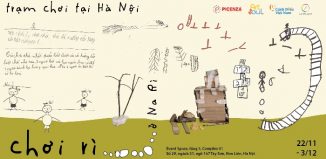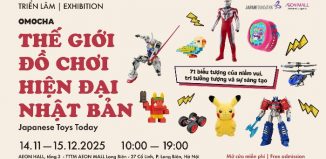Tran Quoc Long – Distilling Tradition to Tell the Story of Contemporary Consciousness
Written by Nga Nguyễn
Images provided by Alpha Gallery
Kindly credit Hanoi Grapevine when sharing the article
Please do not copy or repost without permission
Lacquer painting—a traditional yet extremely challenging medium.
In recent years, the lacquer department at Ho Chi Minh City University of Fine Arts has seen very few students enrolling. Some years, only one or two students graduate from the lacquer painting class.
Why is that? Why is a medium that once was—and still is—a source of pride in Vietnamese fine arts now attracting so little interest?
Let us briefly revisit the history of lacquer painting.
Lacquer has existed and developed for thousands of years in Eastern countries such as China, Japan, Korea, and Vietnam. In Vietnam, for millennia, “sơn ta” (natural lacquer) was primarily used to craft familiar decorative and ritual objects. From temple artifacts such as statues, horizontal lacquered boards, couplets, altar panels, thrones, scroll boxes, wooden bells, and offering trays… to household items like cabinets, tables, trays, and boxes… lacquer was also applied to many different materials such as wood, clay, stone, and bronze.
It was not until the 1920s that French professors, in addition to teaching oil painting, encouraged students at the École des Beaux-Arts de l’Indochine to study traditional materials and integrate them into fine art, including lacquer. Many of Vietnam’s greatest painting masters built their names around lacquer, including: Nguyen Gia Tri – “Vườn Xuân Trung Nam Bắc” (Spring Garden of the Central, South and North Regions), Kim Dong – “Lò Gốm” (Potter’s Kiln), Nguyen Sang – “Chùa Phổ Minh” (Pho Minh Temple), Nguyen Tu Nghiem – “Thánh Gióng” (Saint Giong), Truong Be, Bui Huu Hung, and Dinh Quan…
Thus, Vietnamese lacquer painting has had centuries of rich development. Its allure lies in its fusion of refined, mystical Eastern beauty with a Western artistic sensibility. Even today, works from the Indochine art period continue to be sought after, valued, and traded for millions of dollars.
Yet for today’s younger generation, lacquer painting seems to have lost its “trendiness.” Modern life, with its constant pressures, demands everything to be fast and efficient. Lacquer, however, is slow and meditative. Young people favor freedom and spontaneity, whereas lacquer demands meticulousness and patience.
Working with lacquer is difficult—from the material itself, which can be toxic and cause allergic reactions, to the process, which involves layering, curing, and labor-intensive polishing. The artist must invest in complex materials like “vóc” (the board base), lacquer, pigments, silver and gold leaf… making it more expensive than oil or watercolor painting.
All these factors have caused a decline in students pursuing lacquer.
Despite these challenges, Tran Quoc Long, a relatively young artist, has committed more than 15 years to practicing and mastering this demanding art form.
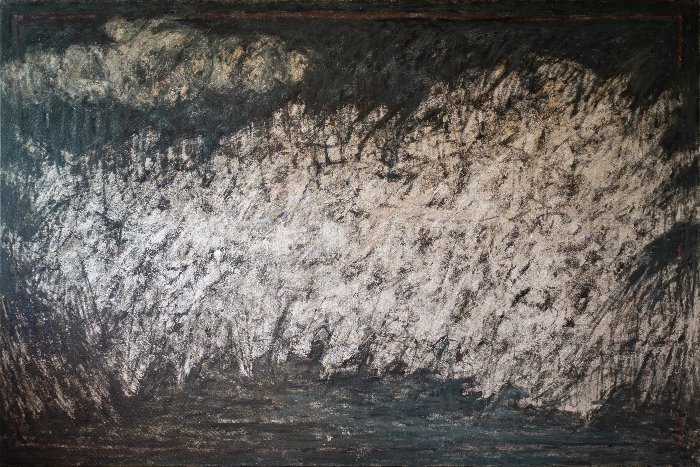
Preserving the Soul of Tradition in a Contemporary Language
Born in 1981 on the Nghi Son peninsula, Thanh Hoa province, Tran Quoc Long graduated from the Vietnam University of Fine Arts, majoring in lacquer painting.
He understands better than anyone the “difficult temperament” of lacquer, yet has chosen it as his life’s path—almost as if by fate.
When speaking with peers, Long often jokes: “Sometimes I don’t feel like a painter, but more like a doctor—a lacquer doctor.” It’s not just a passing remark, but a reflection of years of hands-on experience. As a “lacquer doctor,” he constantly experiments and develops new techniques. For over more than 15 years until now, he has gathered countless lessons, learning how to “treat” the stubborn nature of natural lacquer to create works that are both traditionally grounded and express a spirit of bold, contemporary freedom.
His paintings are deeply rooted in traditional methods and materials such as “vóc”, “then” (black lacquer), “son” (red lacquer), gold, and silver. He retains this foundation faithfully. Yet under his hand, these materials take on a fresh aesthetic. He especially enjoys using fine silver dust and leaves. His gold is often buried under layers of lacquer, then polished down to a flat, matte finish—resisting decorative flashiness.
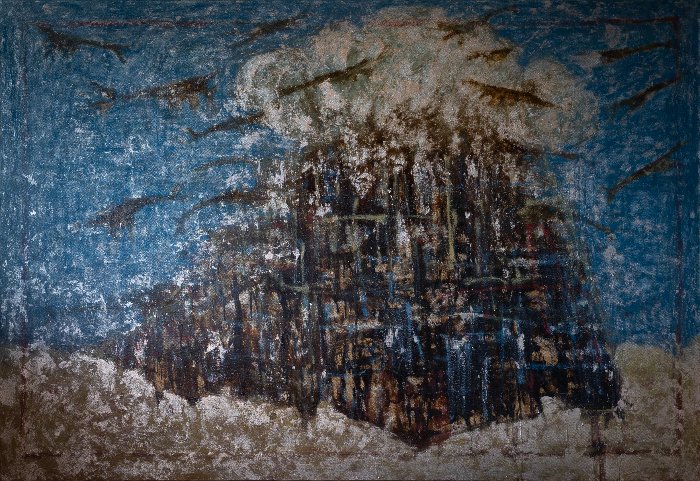
Though he lives and works in Da Lat, Long sources his lacquer boards and materials from Ha Noi. He believes that the centuries-old craft villages of northern Vietnam produce the finest quality materials, thanks to generations of master artisans.
Raw, Rugged Forms That Speak to the Human Life
Don’t look for polished, finely detailed imagery in Tran Quoc Long’s paintings, as he is not concerned with photorealism or decorative finesse.
The figures in his work are not literal representations—they are symbols of thought and existential questioning. His subjects are often portraits of himself and those around him, as seen in “Chân dung Tôi” (My Portrait – “Như Mây Liêu Xiêu” solo exhibition, 2022); “Chân dung người lính” (Portrait of a Soldier – “Mộng Bình Thường” exhibition, 2024)…
His paintings vaguely reflect scenes of homeland or everyday life, but they appear through surreal and sometimes bizarre imagery that defies visual conventions. The artist has created a unique visual language to listen, transform, and express the inner world—his own, and that of our contemporary times.
Long’s lacquer paintings are strikingly flat and luminous. This is especially noticeable in works such as “Những đền đài bỏ hoang” (Deserted Altars) or “Tỉnh mộng” (Awakening) from “Như Mây Liêu Xiêu” solo exhibition in 2022. However, this is not the gloss of synthetic varnish—it’s a soft, natural luster like that of a stone slowly polished over time by a stream. The water, sometimes turbulent, sometimes gentle, wears the jagged edges smooth, eventually revealing a mirror-like clarity, as a rock at the bottom of the river (“Đá ở đáy sông I & II” – “Như Mây Liêu Xiêu” exhibition, 2022).
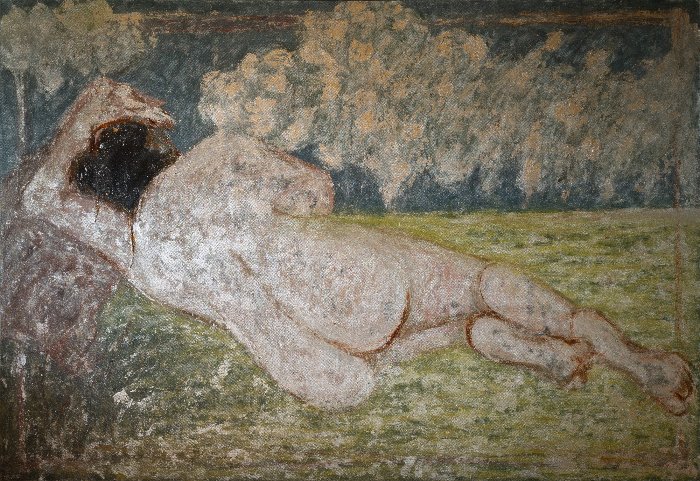
Tran Quoc Long works in a modest space within the comfort of his home. No large studio, no assistants, no elaborate setup. He handles every step himself. In this humble environment, powerful works of high artistic value are steadily born.
To Polish a Painting—An Art Form, or a Philosophy?
Long’s paintings are deep—literally and metaphorically.
His use of multiple layers and patient polishing creates a profound, mystical spatial depth. Artist Le Thiet Cuong once remarked: “You should call him ‘Long Mài’ (Long the Polisher), because he not only understands lacquer thoroughly, but also polishes his works obsessively, layer after layer, to achieve a distinctive depth and color harmony.”
Polishing lacquer is an intricate skill. One must know exactly when to stop to achieve the desired effect. Too little, and the painting is flat and dull. Too much, and the image may be ruined entirely.
Despite these risks, he always chooses to polish—relentlessly. It’s more than technique—it defines who he is.
To live by art is never easy. Making art is hard enough; making a living from it is even harder. Long never compromises with mass-market tastes. He refuses to paint merely decorative images. His works may seem coarse or raw at first glance, but for those who look deeply, a refined, humanistic soul reveals itself. This kind of beauty requires time, reflection, and a discerning eye to recognize its hidden value.
Through solo exhibitions like “Như Mây Liêu Xiêu”, “Mộng Bình Thường”, “3600 Ngày”, and various notable group projects, he has affirmed his place in the current of contemporary Vietnamese lacquer painting. His works are collected both in Vietnam and abroad. He may not make noise, but he always leaves a distinct mark—steady, profound, and never reliant on fleeting popularity.
Art, if only pursued for a few short years as a kind of “play,” offers little to say. But for Tran Quoc Long, nearly two decades of dedication have seen him patiently distill tradition and tell his story—and the story of our time.
And I believe that is his philosophy.

“Illusory Motion” – Exhibition by Tran Quoc Long & Le Van Trong – June 2025
Illusory Motion is a dual exhibition by artists Tran Quoc Long and Le Van Trong—a meeting point between the Eastern essence of traditional lacquer painting and the classical Western technique of oil painting. The exhibition opens up a multidimensional dialogue: between rigidity and softness, roughness and gentleness, rustic authenticity and ephemeral illusion.
In this June 2025 exhibition, Tran Quoc Long presents 19 large-scale lacquer paintings on canvas, continuing to make a bold and inventive artistic statement.
Creating lacquer paintings on canvas is not entirely new—many other artists have had experience with this technique. However, what makes Long’s works captivating is his distinct visual language and color story. His compositions are bold while the strokes are free and spontaneous. While still rooted in expressionism, the looseness and improvisation in his forms make his works lean more towards abstraction. He prefers to use the natural tones of his materials to shape his palette: the deep black of lacquer, the silvery white of metal, the luminous gold from real gold leaf and so on.
It’s hard to look away from works like “Đàn chim trở về” (Flock Returning), “Phía sau một cánh rừng” (Beyond the Forest), “Tháng Tư về” (April Returns), “Đàn Cá” (The School of Fish), or “Cánh đồng hoang” (Desolate Field). Long’s paintings are best experienced in person—their photographed versions hardly capture the spirit or tactile richness of the material.
Tran Quoc Long’s paintings are not meant to merely please the eye—they ask the viewer to pause for a moment and contemplate—like gazing into a reflective pool, where both tradition and the self quietly emerge from the surface.


